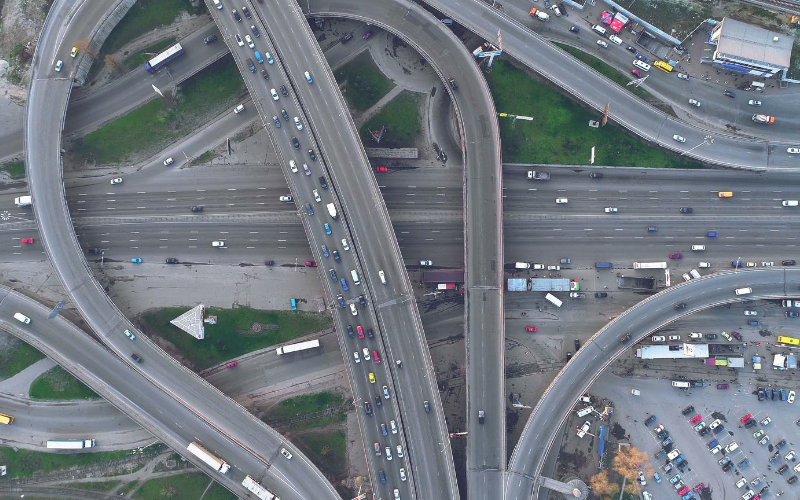Making Sense of Motoring Jargon
Share

Making Sense of Motoring Jargon
Trying to understand the terminology and phrases related to automobiles can be mind-boggling and, after a while, your head might start to hurt.
It can get as confusing as trying to figure out that road layout, above! But do not fear... we’re here to un-boggle your brain and help you make sense of motoring jargon.
Understanding Car Speak
Oversteer, understeer, horsepower, brake horsepower... it’s exhaustive just reading out all these words, never mind trying to understand them as well.
It can all get a little confusing (and sometimes frustrating) when you see all these words being used by motoring journalists, dealerships and petrolheads... especially when you have no idea what they mean!
That’s why we’ve created this guide to help you understand all the motoring jargon out there, so that when you’re next reading a car review or looking for a new car, you’ll know exactly what they’re talking about and how it relates to the vehicle.
All-wheel drive
Also known as AWD, this is where power is provided to all four wheels at the same time... all the time!
Most power will be sent to the front wheels, but if road conditions become slippery, power will be distributed evenly to the rear wheels to improve control and grip, with very little chance of wheels spinning, providing a safer journey, especially in rain and snow.
Anti-lock brakes (ABS)
Anti-lock brakes come as standard in new models, optimising the safety of drivers and passengers when braking.
The ABS system stops wheels from locking when braking, which prevents any possibility of skidding and reduces stopping distances.
Brake horsepower (BHP)
Brake horsepower, also known as BHP, is the amount of power produced by the engine and is measured by seeing how much power is needed when braking. Horsepower measures the output power of an engine, whilst BHP measures the input power... the higher the BHP the more powerful and quicker the car will be.
Engine size
Engines can come in a variety of sizes and are commonly measured in litres. Generally, the bigger the engine the more powerful the car is and the more fuel it can hold. However, the development of turbocharged engines has meant that smaller engines are much more powerful than they used to be and offer great fuel economy.
Grip
Grip is what helps keep you on the right track! It optimises control when braking, cornering and accelerating for a sturdy drive.
Horsepower
As much as this sounds like something you would expect to hear at the Grand National, horsepower is a common terminology used when it comes to cars... and weirdly enough, it has nothing to do with horses.
Usually written as ‘HP’, horsepower is a unit of measurement used to decipher how powerful the engine is. If your vehicle has high horsepower, it means it will be faster and gain speed quickly when accelerating.
Miles per gallon (mpg)
Miles per gallon (mpg) simply means how far the vehicle can go on a gallon of fuel (approx. 3.7 litres). For instance, if your car offers 60mpg, it can deliver 60 miles of range to one gallon of fuel.
The higher the mpg, the more fuel efficient your vehicle is.
Oversteer
Oversteer is when the car turns more than the driver wanted it to. For instance, when cornering, the rear wheels may lose grip, causing the vehicle to slide or complete a full spin.
PS
Similar to HP, PS is another measure of an engine’s power. Also known as Pferdestarke, which means ‘horse strength’ in German, PS is very similar to horsepower and can be used to measure how much power the engine provides.
Torque
Yes, we know this sounds like the name of a Marvel character, but it actually refers to how quick off the mark your vehicle is.
The higher the torque, the more reactive your vehicle will be, which is great for driving situations where you need to be quick out the blocks, such as tackling junctions, roundabouts and traffic lights.
Traction
Just like grip, traction keeps you firmly on the road and prevents the car from slipping or skidding out of control.
Turbos
Turbo, turbocharged engines, turbos... whichever way you see this word, it means the same thing.
Nowadays, turbos are fitted in most modern cars and work to enhance efficiency and power of the engine.
Understeer
Understeer is the opposite of oversteer. Rather than the rear wheels slipping, the front wheels lose grip and cause you to understeer and can occur when you’re going to fast or braking too hard whilst trying to steer. Instead of turning, the car keeps going forward.
To prevent this, all you need to do is drive slower!
V6/V8/V10/V12/W12 etc.
Appearing as confusing as an algebra equation, these formulas refer to the engine style of your vehicle.
The letter in the formula represents the foundational shape of the engine (for instance, V is made up of two cylinders in the shape of the letter) whilst the number signifies the number of other cylinders used, which impacts performance and power.
So, there you have it... your own dictionary of motoring jargon to make your driving life easier! If there are some words you think we’ve missed out, then tweet us at @bristolstmotors and let us know!
Want to learn more?
We also have a range of guides to help you understand other aspects related to the automotive world, including the Motability Scheme, car finance and driving modes. So, make sure to check them out and you’ll be an automotive pro in no time!